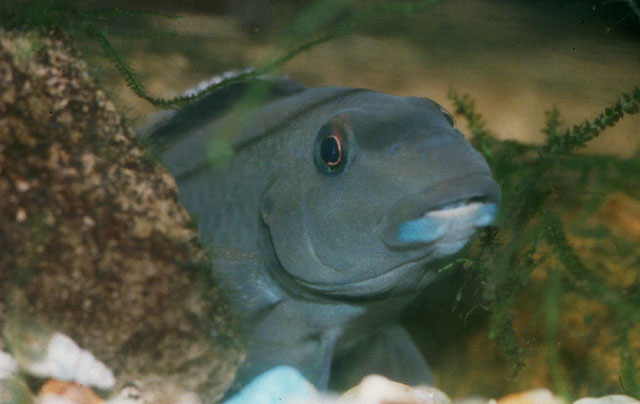| Cichlidae (Cichlids), subfamily: Pseudocrenilabrinae |
| 10.7 cm SL (male/unsexed) |
|
demersal; freshwater |
| Africa: endemic to the Volta River drainage in Ghana and Burkina Faso (Ref. 7378, 122069). |
|
Dorsal spines (total): 20-21; Dorsal soft rays (total): 8-10; Anal spines: 3-3; Anal soft rays: 6-8. Description: body slender (Ref. 52307), elongate, its depth 24.0-25.8% SL and head length 30.3-32.3% SL (Ref. 53405). Outer jaw teeth bicuspid; upper jaw with 3 inner rows of tricuspid teeth, lower jaw with a single row of conical, sometimes tricuspid teeth; lower pharyngeal bone with conical teeth (Ref. 53405). Upper jaw overlapping; opercle squamate (Ref. 52307).
Coloration: ground colour greenish-grey, blackish green on back, lighter on belly and underside of head; 7 irregular, darker greyish green cross-bars on sides and dark band between mouth and eye; "tilapian" mark present at base of soft part of dorsal fin; distal margin of dorsal fin with black spots between spinous rays; gill cover with black blotch (Ref. 53405). Body coloration may be nearly black especially in aggressive or dominant specimens; lower lip blue; dorsal fin with white seam, usually better developed in females; some males with a reddish or green-yellowish coloration in unpaired fins; 2 longitudinal stripes sometimes visible (Ref. 52307). |
| Less rheophilic and a more active swimmer than Steatocranus species (Ref. 52307). Maximum TL was recorded at 13.4 cm (Ref. 5696). |
|
Least Concern (LC); Date assessed: 14 January 2020 Ref. (130435)
|
| harmless |
Source and more info: www.fishbase.org. For personal, classroom, and other internal use only. Not for publication.

